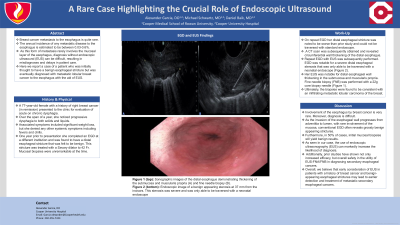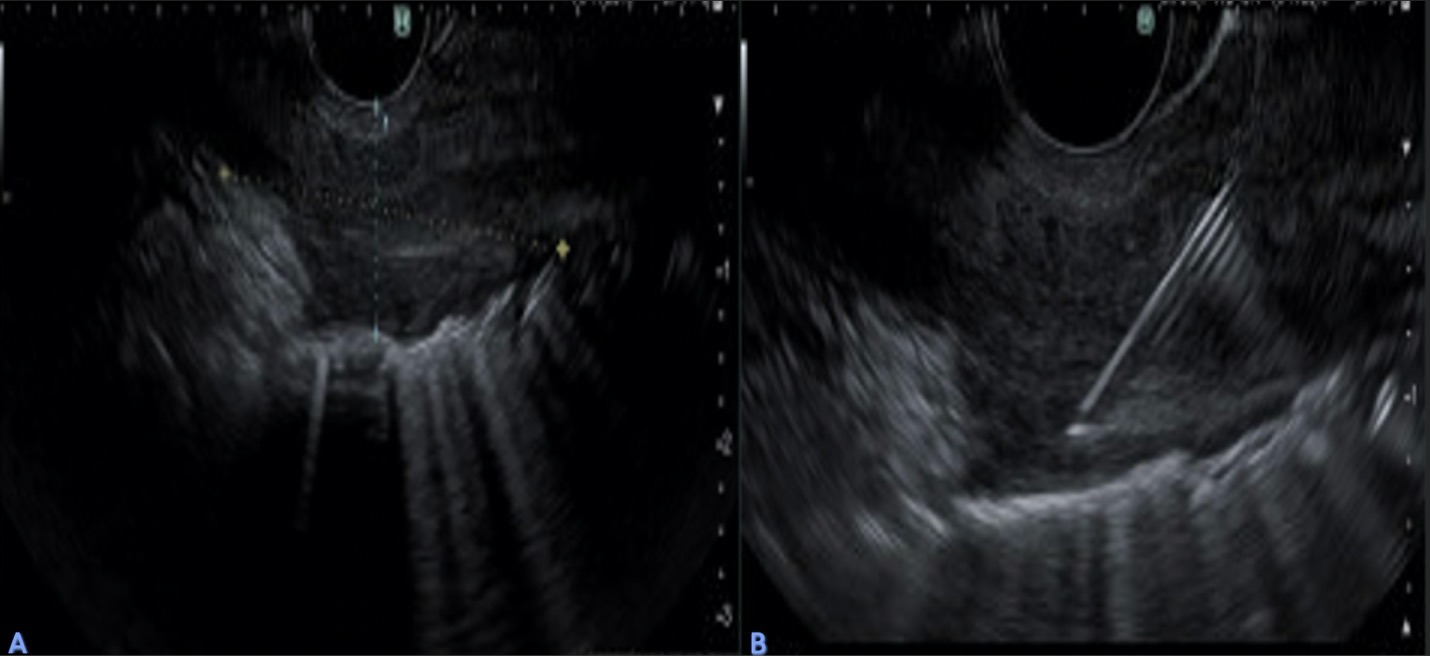Monday Poster Session
Category: General Endoscopy
P1999 - Esophageal Involvement by Metastatic Breast Cancer: A Rare Case Highlighting the Crucial Role of Diagnostic Endoscopic Ultrasound
Monday, October 23, 2023
10:30 AM - 4:15 PM PT
Location: Exhibit Hall

Has Audio

Alexander Garcia, DO
Cooper University Hospital
Camden, NJ
Presenting Author(s)
Alexander Garcia, DO, Michael Schwartz, MD, Daniel Baik, MD
Cooper University Hospital, Camden, NJ
Introduction: Breast cancer metastasis to the esophagus is quite rare. The annual incidence of any metastatic disease to the esophagus is estimated to be between 0.03-0.6%. As this form of metastasis rarely involves the mucosal layer of the esophagus, diagnosis without endoscopic ultrasound (EUS) can be difficult, resulting in misdiagnoses and delays in patient care. Here we report a case of a patient who was initially thought to have a benign esophageal stricture but was eventually diagnosed with metastatic lobular breast cancer to the esophagus with the aid of EUS.
Case Description/Methods: A 77-year-old female with a history of right breast cancer (in remission) presented to our clinic for evaluation of acute on chronic dysphagia. She reported progressive solid and liquid dysphagia over the past year. Initial EGD at that time at an outside hospital demonstrated a distal esophageal stricture that was felt to be benign and treated with a Savary dilator to 42 Fr. Mucosal biopsies were unremarkable. Her symptoms briefly improved but her dysphagia recurred, and the stenosis was unable to be traversed on a subsequent EGD. A CT scan demonstrated moderate circumferential wall thickening of the distal esophagus and an EUS was performed. The EUS was notable for distal esophageal wall thickening in the submucosa and muscularis propria and fine needle biopsy (FNB) was performed with a 22g core biopsy needle. Ultimately, the biopsies were found to be consistent with an infiltrating metastatic lobular carcinoma of the breast.
Discussion: Involvement of the esophagus by breast cancer is very rare. Moreover, diagnosis is difficult. As the invasion of the esophageal wall progresses from adventitia to lumen, with rare involvement of the mucosa, conventional EGD often reveals grossly benign appearing strictures. Furthermore, in 50% of cases, initial mucosal biopsies will yield benign results. As seen in our case, the use of endoscopic ultrasonography (EUS) can markedly increase the likelihood of diagnosis. Additionally, prior studies have shown not only increased efficacy, but overall safety in the utility of EUS-FNA/FNB in diagnosing secondary esophageal cancers. Overall, we believe that early consideration of EUS in patients with a history of breast cancer and benign-appearing esophageal strictures may lead to earlier detection and treatment of metastatic secondary esophageal cancers.

Disclosures:
Alexander Garcia, DO, Michael Schwartz, MD, Daniel Baik, MD. P1999 - Esophageal Involvement by Metastatic Breast Cancer: A Rare Case Highlighting the Crucial Role of Diagnostic Endoscopic Ultrasound, ACG 2023 Annual Scientific Meeting Abstracts. Vancouver, BC, Canada: American College of Gastroenterology.
Cooper University Hospital, Camden, NJ
Introduction: Breast cancer metastasis to the esophagus is quite rare. The annual incidence of any metastatic disease to the esophagus is estimated to be between 0.03-0.6%. As this form of metastasis rarely involves the mucosal layer of the esophagus, diagnosis without endoscopic ultrasound (EUS) can be difficult, resulting in misdiagnoses and delays in patient care. Here we report a case of a patient who was initially thought to have a benign esophageal stricture but was eventually diagnosed with metastatic lobular breast cancer to the esophagus with the aid of EUS.
Case Description/Methods: A 77-year-old female with a history of right breast cancer (in remission) presented to our clinic for evaluation of acute on chronic dysphagia. She reported progressive solid and liquid dysphagia over the past year. Initial EGD at that time at an outside hospital demonstrated a distal esophageal stricture that was felt to be benign and treated with a Savary dilator to 42 Fr. Mucosal biopsies were unremarkable. Her symptoms briefly improved but her dysphagia recurred, and the stenosis was unable to be traversed on a subsequent EGD. A CT scan demonstrated moderate circumferential wall thickening of the distal esophagus and an EUS was performed. The EUS was notable for distal esophageal wall thickening in the submucosa and muscularis propria and fine needle biopsy (FNB) was performed with a 22g core biopsy needle. Ultimately, the biopsies were found to be consistent with an infiltrating metastatic lobular carcinoma of the breast.
Discussion: Involvement of the esophagus by breast cancer is very rare. Moreover, diagnosis is difficult. As the invasion of the esophageal wall progresses from adventitia to lumen, with rare involvement of the mucosa, conventional EGD often reveals grossly benign appearing strictures. Furthermore, in 50% of cases, initial mucosal biopsies will yield benign results. As seen in our case, the use of endoscopic ultrasonography (EUS) can markedly increase the likelihood of diagnosis. Additionally, prior studies have shown not only increased efficacy, but overall safety in the utility of EUS-FNA/FNB in diagnosing secondary esophageal cancers. Overall, we believe that early consideration of EUS in patients with a history of breast cancer and benign-appearing esophageal strictures may lead to earlier detection and treatment of metastatic secondary esophageal cancers.

Figure: Sonographic images of the distal esophagus demonstrating thickening of the submucosa and muscularis propria (A) and fine needle biopsy (B).
Disclosures:
Alexander Garcia indicated no relevant financial relationships.
Michael Schwartz indicated no relevant financial relationships.
Daniel Baik indicated no relevant financial relationships.
Alexander Garcia, DO, Michael Schwartz, MD, Daniel Baik, MD. P1999 - Esophageal Involvement by Metastatic Breast Cancer: A Rare Case Highlighting the Crucial Role of Diagnostic Endoscopic Ultrasound, ACG 2023 Annual Scientific Meeting Abstracts. Vancouver, BC, Canada: American College of Gastroenterology.
